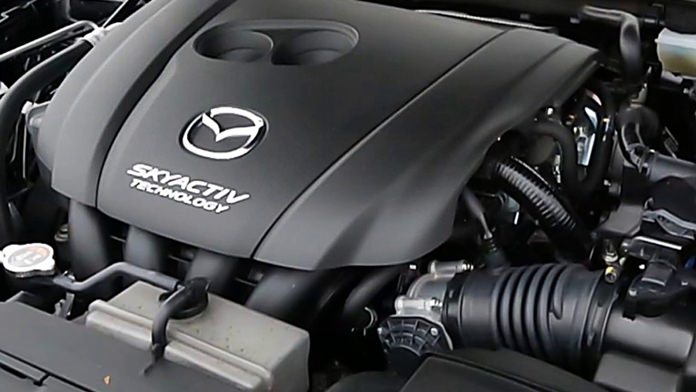
Mazda has revealed plans to introduce a world-first mass-produced compression-ignition petrol engine that it claims will be at least as fuel-efficient as diesel while improving power and driveability.
This new direction is called SkyActiv-X, and the engine will debut in 2019 as part of the company’s newly announced Sustainable Zoom Zoom 2030 long-term strategy, so they’ve got 13 years to perfect it.
Mazda calls the technology Spark Controlled Compression Ignition and claims it is the first commercial use of such technology.
(A number of other manufacturers have used the technology in various forms and trials, but Mazda is the first to use it in a mass-produced vehicle.)
Like diesel, the petrol fuel-air mixture ignites when compressed by the piston.
Mazda says its version of the engine tech overcomes two issues that have held it back from wider use – “maximizing the zone in which compression ignition is possible and achieving a seamless transition between compression ignition and spark ignition”.
Fitted with the compression ignition and a supercharger, the SkyActiv-X engines boost fuel economy and can lift torque output by 10 to 30 percent compared with current-generation SkyActiv-G petrol units.
Compression ignition can also improve fuel efficiency by 20 to 30 percent over the existing petrol engines and equal or exceed the fuel use of a SkyActiv-D diesel engine.
While Mazda is talking up the environmental benefits of the new tech, the company says it will aid driving performance and acceleration.
Mazda has not divulged the models that will be first to use the compression ignition engines, but it is believed that smaller next-gen models such as the Mazda2, Mazda3 and CX-3 could be first in line.
The new environmental strategy follows on from the company’s Sustainable Zoom Zoom plan from 2007, with Mazda stating that it “believes its mission is to bring about a beautiful earth and to enrich people’s lives as well as society”. Under the new plan, Mazda aims to reduce its corporate average “well-to-wheel” carbon dioxide emissions by as much as 50 per cent over its 2010 levels by 2030, increasing this to 90 per cent by 2050.
Mazda emphasized its commitment to internal combustion engines by stating that it will continue to “perfect” the engine as it believes it will power “the majority of cars worldwide for many years to come and can therefore make the greatest contribution to reducing carbon dioxide emissions, and combine the results with effective electrification technologies”.
As reported last year, Mazda has confirmed that it will introduce electric vehicles into markets where sufficient green energy available, along with those that are cracking down on internal combustion engines, which would point to Europe the UK and China as well as some states in the US.
The new strategic plan also states that Mazda will develop and roll out more active safety gear under its i-Activsense banner as the company works towards eliminating traffic accidents.
Mazda will begin testing autonomous driving technology as part of its Mazda Co-Pilot Concept, with a goal of making all of the self-driving systems standard across its model range by 2025.
More details of the SkyActiv-X powertrains will likely come to light later this month when Mazda hosts a technology forum ahead of the Frankfurt motor show.
It does sound at this stage that Mazda is backing every horse in the race with forthcoming electric vehicles, Internal Combustion engines and its Compression Ignition as well. I do agree with their concept that the ICE will be around for a long time yet.




